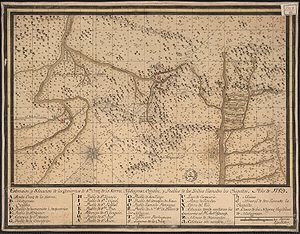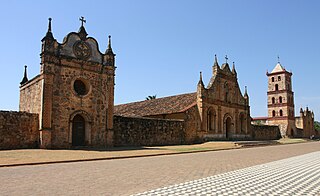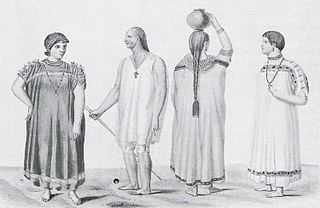
Chiquitania ("Chiquitos" or "Gran Chiquitania") is a region of tropical savannas in the Santa Cruz Department in eastern Bolivia.

Chiquitania ("Chiquitos" or "Gran Chiquitania") is a region of tropical savannas in the Santa Cruz Department in eastern Bolivia.
"Chiquitos" is the colonial name for what is now essentially five of the six provinces that make up the Chiquitania, a region in Bolivia's Santa Cruz department. "Chiquitos" refers to a region, not a tribe.[ citation needed ]
Today, the Chiquitania lies within five provinces of Santa Cruz Department: Ángel Sandoval, Germán Busch, José Miguel de Velasco, Ñuflo de Chávez and Chiquitos province. [1] [2] [3]
One of the many tribes inhabiting Chiquitos were the Chiquitano, who still speak the Chiquitano language today. [4]
Languages historically spoken in the Chiquitania included:
Today, Camba Spanish is the main vernacular lingua franca.
A notable feature are the 18th-century Jesuit reductions and Franciscan settlements scattered throughout the region. Six churches still remain in the zone and were selected in 1990 as UNESCO World Heritage Sites under the name Jesuit Missions of the Chiquitos .[ citation needed ]
The Chiquitano dry forest is the ecosystem which connects South America's two largest biomes, the Amazon and the Gran Chaco, a dense dry forest of thorn-covered trees and scrub that extends south into Paraguay and Brazil. [5]

José Miguel de Velasco or Velasco is a province in the Santa Cruz department of Bolivia. Its capital is San Ignacio de Velasco. The province is named after the Bolivian president José Miguel de Velasco Franco. It was created by law on October 12, 1880, during the presidency of Narciso Campero. Until its creation it was integrated into Chiquitos Province.
Chiquitano is an indigenous language isolate spoken in the central region of Santa Cruz Department of eastern Bolivia and the state of Mato Grosso in Brazil.

San Ignacio de Velasco, is the capital of the José Miguel de Velasco Province and the San Ignacio de Velasco Municipality in the Santa Cruz Department of Bolivia.

The Llanos de Moxos, also known as the Beni savanna or Moxos plains, is a tropical savanna ecoregion of the Beni Department of northern Bolivia.

Concepción is a town in the lowlands of eastern Bolivia. It is known as part of the Jesuit Missions of Chiquitos, declared in 1990 a World Heritage Site, as a former Jesuit Reduction.

The Jesuit Missions of Chiquitos are located in the Santa Cruz department in eastern Bolivia. Six of these former missions collectively were designated as a UNESCO World Heritage Site in 1990. Distinguished by a unique fusion of European and Amerindian cultural influences, the missions were founded as reductions or reducciones de indios by Jesuits in the 17th and 18th centuries to convert local tribes to Christianity.

Ñuflo de Chávez is one of the fifteen provinces of the Bolivian Santa Cruz Department and is situated in the northern and central parts of the department. The name of the province honors the conquistador Ñuflo de Chaves (1518–1556) who founded the city of Santa Cruz de la Sierra. Its capital is Concepción. The province was created by law of September 16, 1915, during the presidency of Ismael Montes. Originally it was part of the Chiquitos Province.

Chiquitos Province is one of the fifteen provinces of the Bolivian Santa Cruz Department, situated in the center of the department. Its capital is San José de Chiquitos.

San Rafael de Velasco or San Rafael is the seat of the San Rafael Municipality in the José Miguel de Velasco Province, Santa Cruz Department, Bolivia. It is part of the Jesuit Missions of Chiquitos. In 1990 it was declared a World Heritage Site.

San José de Chiquitos, or simply San José, is the capital of Chiquitos Province in the Santa Cruz Department, Bolivia. It is known as part of the Jesuit Missions of the Chiquitos, which is declared in 1990 a World Heritage Site, as a former Jesuit Reduction.

San Javier is the seat of San Javier Municipality in Ñuflo de Chávez Province, Santa Cruz Department, Bolivia. The mission of San Javier is known as part of the Jesuit Missions of the Chiquitos, declared in 1990 a World Heritage Site, as a former Jesuit Reduction.

San Miguel de Velasco or simply San Miguel is a town in the Santa Cruz Department, Bolivia. It is the capital of San Miguel Municipality, the second municipal section of José Miguel de Velasco Province. It is known as part of the Jesuit Missions of the Chiquitos, which was declared a World Heritage Site in 1990, as a former Jesuit Reduction. The wood and adobe church has an elaborate interior.

Santa Ana de Velasco is a small town in the Santa Cruz Department, Bolivia.
Gorgotoqui is a currently undocumented extinct language of the Chiquitania region of the eastern Bolivian lowlands. It may have been a Bororoan language.

Martin Schmid, also known as Esmid was a Swiss Jesuit, missionary, musician and architect, who worked mainly in the Chiquitos Province of what is now Bolivia.

The Chiquitano or Chiquitos are an indigenous people of Bolivia, with a small number also living in Brazil. The Chiquitano primarily live in the Chiquitania tropical savanna of Santa Cruz Department, Bolivia, with a small number also living in Beni Department and in Mato Grosso, Brazil. In the 2012 census, self-identified Chiquitanos made up 1.45% of the total Bolivian population or 145,653 people, the largest number of any lowland ethnic group. A relatively small proportion of Bolivian Chiquitanos speak the Chiquitano language. Many reported to the census that they neither speak the language nor learned it as children. The Chiquitano ethnicity emerged among socially and linguistically diverse populations required to speak a common language by the Jesuit Missions of Chiquitos.

Santiago de Chiquitos is a small town in Roboré Municipality in Chiquitos Province, Santa Cruz Department, Bolivia. The mission of Santiago de Chiquitos is one of the Jesuit Missions of the Chiquitos.
San Juan de Taperas is a village in San José de Chiquitos Municipality in Chiquitos Province, Santa Cruz Department, Bolivia. The ruins of the mission of San Juan Bautista, one of the Jesuit Missions of the Chiquitos, lie near the village. Since only the ruins of a stone tower survive near the present village of San Juan de Taperas, San Juan Bautista is not one of the six Jesuit Missions of Chiquitos recognized as UNESCO World Heritage Sites.
Santo Corazón is a village in San Matías Municipality in Ángel Sandoval Province, Santa Cruz Department, eastern Bolivia. The mission of Santo Corazón is one of the Jesuit Missions of the Chiquitos.
San Ignacio de Zamucos or San Ignacio was a Jesuit mission in Santa Cruz Department, Bolivia that was founded in 1724 and abandoned in 1745. The inhabitants of the mission were the Zamucoan-speaking Ayoreo.